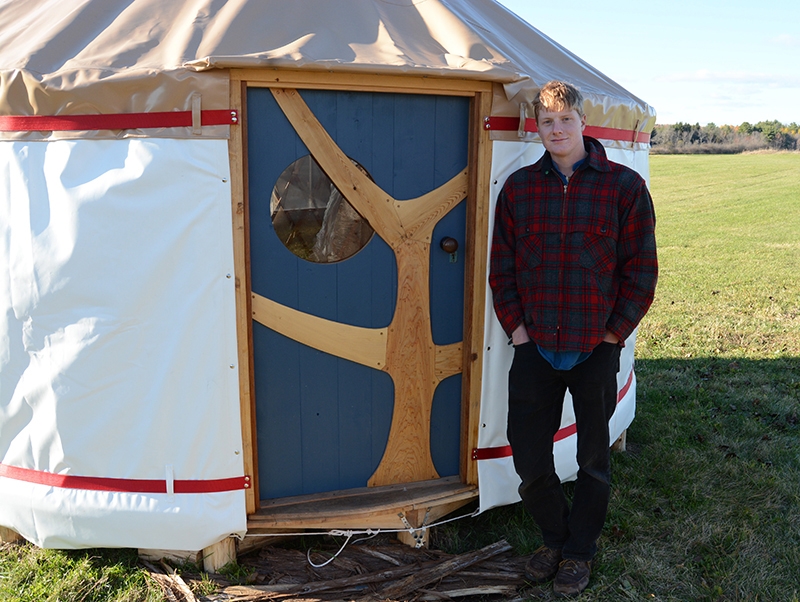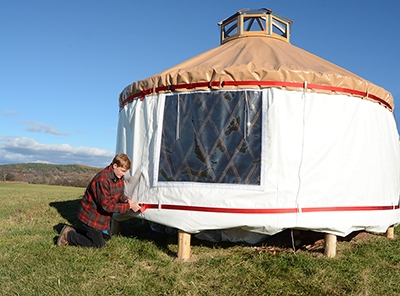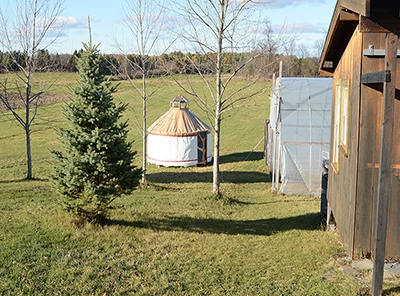A Yurt of One’s Own

MIDDLEBURY, Vt. – Milo Stanley ’17.5 was daydreaming of a room of his own — and a dorm room wasn’t going to cut it.
The lanky junior Feb jokes that he grew up “mostly alone in the woods of Maine,” a homeschooled kid who was as at ease in his father’s carpentry shop as he was in front of a book.
“I still really enjoy spending time by myself, and that can be hard to find on campus,” said Stanley. And so he set out to make his own space on a campus that, for all its rural spaciousness, sometimes felt too crowded. He daydreamed of building a sod house, or an apartment in an old barn silo, or a hidden tree house.
In the end, he settled on this: a little yurt, tucked just beyond the crest of a hill at the Middlebury College Organic Farm. Topped with an octagonal cupola — his homage to Old Chapel — the yurt is Stanley’s experiment in solitude on a bustling residential campus.
Helping to smooth the way for Stanley was Vice President for Student Affairs and Dean of the College Katy Smith Abbott, who’d previously taught Stanley in a Renaissance art class, and she helped Stanley make his idea for a yurt a reality after hearing about his plans.
“I think that one of the things that’s so captivating about this project, and so inspiring, is that here is a young person who has spent essentially his whole life pursuing a different way of thinking about living, and about being in the world,” said Smith Abbott.
“I was just mesmerized by the fact that he wanted to continue, in this very demanding period of time in college, to honor this curiosity about living and building and retreating,” said Smith Abbott. The project seemed especially meaningful as the College community collectively thought about resilience, stress, and mindfulness.


Stanley’s interest in yurts dates back years. When he was 12 or so, he stumbled across a book called A Handmade Life, by Bill Coperthwaite — what Publishers Weekly called the “rambling scrapbook” of a Maine native interested in self-sufficiency and simplicity. And, it turned out, in yurt building; Coperthwaite, who died in 2013, was a pioneer of the yurt in the United States. The adolescent Stanley wrote Coperthwaite a letter, and in response Coperthwaite invited the boy and his family for a visit. Soon Coperthwaite was a fast family friend.
When Stanley set out to build his own yurt, he ultimately eschewed the Coperthwaite model — by design, a more permanent structure — in favor of a Mongolian yurt. The portable round tents are the traditional dwellings of nomads in the steppes of Central Asia; building a yurt that could be disassembled, moved, and then built anew meant that Stanley can, and will, take his yurt with him at the end of the academic year.
He spent last spring working on his yurt’s design in the Old Stone Mill, the College’s space for creative, non-academic endeavors. Over the summer, while working for his fourth year at the Wooden Boat School in Maine, Stanley spent his nights and weekends at work on his yurt. The complicated cupola proved especially time consuming. He used cedar for the lattice walls, and designed a floor that breaks into sections for portability. Saplings arch toward the peak of the roof, and carved leaves encircle the top ring of the yurt; the carvings were Stanley’s mother’s contribution to the design. His father sketched the design for the “cellar” — a little storage compartment, about three feet deep, that sits below a trap door in the center of the yurt.
Inside Stanley’s yurt, there’s a simple coat rack on the wall, and slates upon which Stanley rests his shoes. He’s turned the backseat of a 1981 Volkswagen Rabbit into a makeshift couch. There are some pillows and pads on the floor for visiting guests, and a few mugs for tea.
“I’ve always had a thing for small spaces,” said Stanley, who after summers spent building boats hopes to live aboard one someday. “I really take comfort in small, cozy, handmade spaces like this.”
The yurt isn’t open to the public, but there’s a pad of paper and pencil tucked into a place outside the door for visitors who want to leave Stanley a note should they find the yurt locked while Stanley is out. Through the fall, he’s spent long afternoons here, studying and reading. Without a stove to heat the space, he suspects he’ll have to cut back on his visits a bit — though the insulated cover does keep the space warm, and he’s looking forward to swapping his bike for cross-country skis on the trek out to the farm.
After all, said Stanley, “It’s really nice to have a place to escape to.”
-With reporting by Kathryn Flagg ‘08 and photos by Robert Keren

